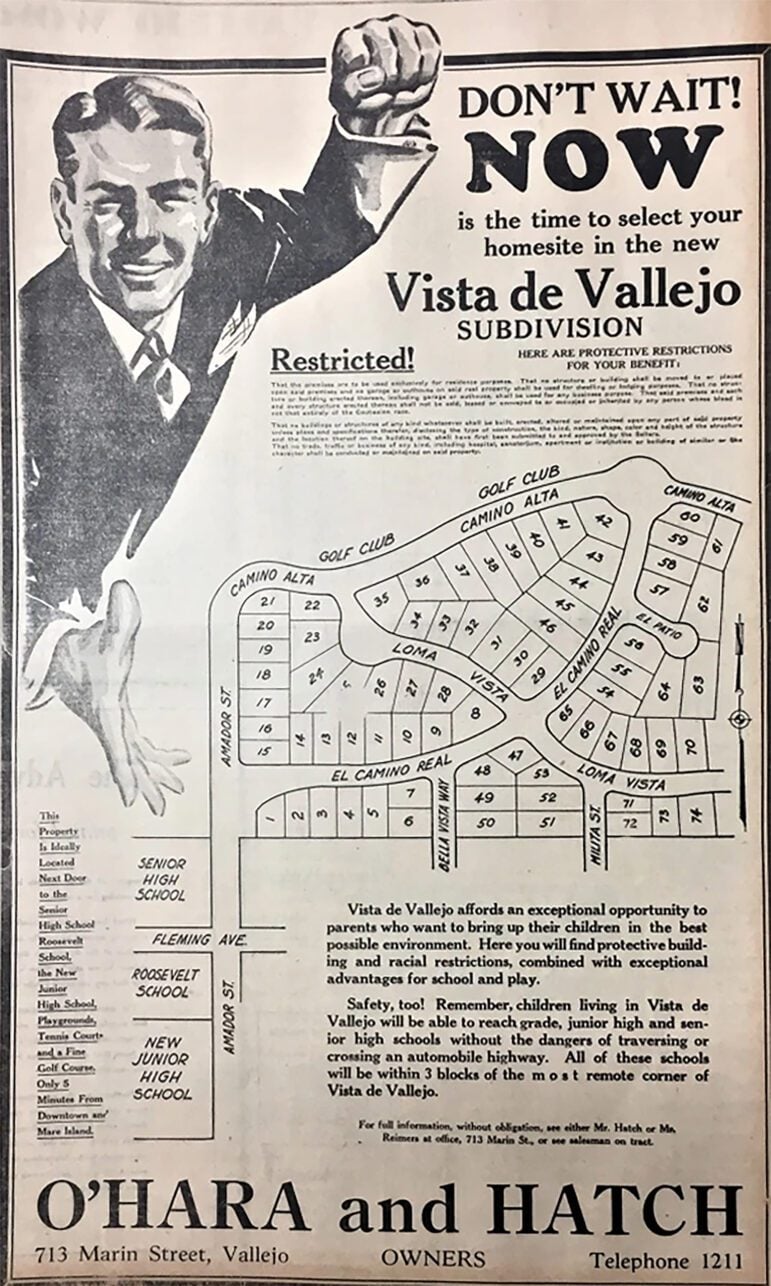
Public domain
A 1932 advertisement for the exclusionary “Vista de Vallejo” neighborhood that ran in the Vallejo Evening Chronicle. Credit: Public domainCurrent U.S. Census statistics show that Vallejo is one of the most diverse cities in the nation. But it wasn’t always that way, due to various discriminatory factors. This column focuses on one key element: race-restricted housing projects built in the 1930s and 1940s across a broad swath of our community.
Research into newspaper real estate ads and Solano County deed records covering those years shows that restrictions in at least a dozen large developments limited the sale or rental of homes to white residents. Such restrictions, eventually found to be unconstitutional and unenforceable, were commonplace throughout the San Francisco Bay Area and the rest of the nation at the time.
All told, plans for these 12 developments called for about 3,500 homes. More research is likely to reveal still more restricted Vallejo-area subdivisions and push that home site total higher.
The newspaper ads and county records show that on the east side of Interstate 80, race-restricted Vallejo-area subdivisions built in the 1940s on what had been mostly ranch and farmland included Steffan Manor, Liberty Heights, Hiltons Addition and Castlewood Gardens. Another restricted project, the Highway Homes subdivision, was located on both sides of the highway.
On the west side of Interstate 80, subdivisions with Caucasian-only restrictions included Vista de Vallejo, Winslow Terrace, Greenfield Terrace, Fairmont Gardens, Leachman Park, Vallejo Highlands and Morningside Addition. The construction time frame on these developments was longer, dating to the early 1900s for Leachman Park and the early 1930s for the Vista.
Examples of the Jim Crow-type of wording that home-buyers in those subdivisions had to accept include this one from the Highway Homes project: “Neither said real property nor any interest therein, nor improvements thereon, shall be used or occupied by any member of other than Caucasian Race, but persons not of Caucasian Race may be kept thereon by a Caucasian occupant strictly in the capacity of servants of such occupant.”
In the case of the Vista de Vallejo subdivision, a 1932 Times-Herald newspaper ad stated that “premises and each and every structure erected thereon shall not be sold, leased or conveyed to or occupied or inherited by any person whose blood is not that entirely of the Caucasian race.”
The wording was included in lists of obligations, typically restrictive covenants or homeowner association bylaws, that homebuyers assumed. Their use was endorsed in a 1926 U.S. Supreme Court ruling that stood until 1948 when the high court held it was unconstitutional to enforce them.
The court’s 1948 Shelley v. Kraemer decision was unanimous, 6–0. Three of the nine justices excused themselves from participating because their objectivity might have been challenged — there were racial restrictions covering the homes in which they lived.

Public domain
The front page of the May 3, 1948 St. Louis Star and Times. Credit: Public domainDespite the court’s ruling, author Richard Rothstein, in his 2017 book The Color of Law: A Forgotten History of How Our Government Segregated America, wrote that the Federal Housing Administration and other federal agencies evaded and subverted the 1948 ruling, helping to preserve discriminatory “redlining” in housing for many more years. That appears to have been the case in Vallejo.
In 1960, 12 years after the Supreme Court decision, the U.S. Census showed that Vallejo was about 80 percent White and 16.5 percent Black. A breakdown shows that on the heavily race-restricted east side of Interstate 80 it was 95 percent white and only 3.3 percent Black. In one of the east-side developments, Castlewood Gardens, it was 99.4 percent white. The opposite was true on the north side of Vallejo for Country Club Crest, developed in the 1950s and marketed to African Americans: In 1960 it was 91.5 percent Black and 6.9 percent white.
The changes since then have been dramatic. A January 2022 report by National Demographics Corp., done as part of Vallejo’s redistricting and based on the 2020 Census, showed much of the greatly expanded East Vallejo area with a current voting-age population that’s 27 percent white, 16 percent Black, 11 percent Hispanic-Latino and 43 percent Asian-Pacific Islander.
The same report shows that the north side of Vallejo, which also has seen major growth over the years, now has a voting-age population that’s 16 percent white, 25 percent Black, 33 percent Asian-Pacific Islander and 23 percent Hispanic-Latino. For the entire city of Vallejo, the current cultural and racial melting-pot aspect is clear: the voting-age population is 31 percent white, 23 percent Black, 18 percent Hispanic-Latino and 26 percent Asian-Pacific Islander.
The whites-only wording in covenants and homeowner association bylaws now may be unenforceable, but Rothstein and other experts say they contributed to a longstanding wealth gap that hurt people of color. Those excluded from the housing market years ago were prevented from building home equity, often a stepping stone to wealth that can be passed down over generations.
The racial restrictions can still turn up in a home’s title report, with a disclaimer saying they are void. In 2000, California established a process for homeowners who want to go a step further, allowing them to add a document to their file with the racial language deleted. The redacted document sits atop the original but do not replace it. However, the Solano County Assessor-Recorder’s office says there has been no rush by local homeowners to submit the necessary paperwork to modify their property records.



